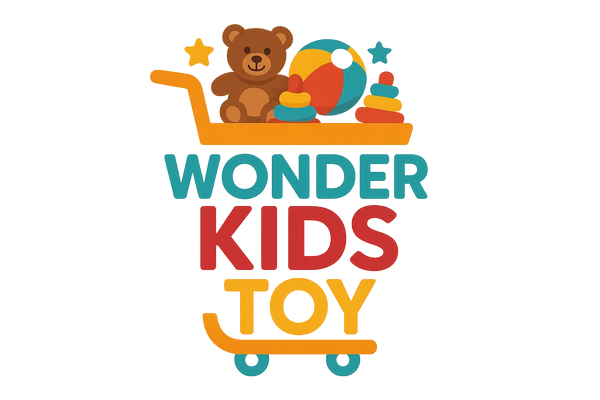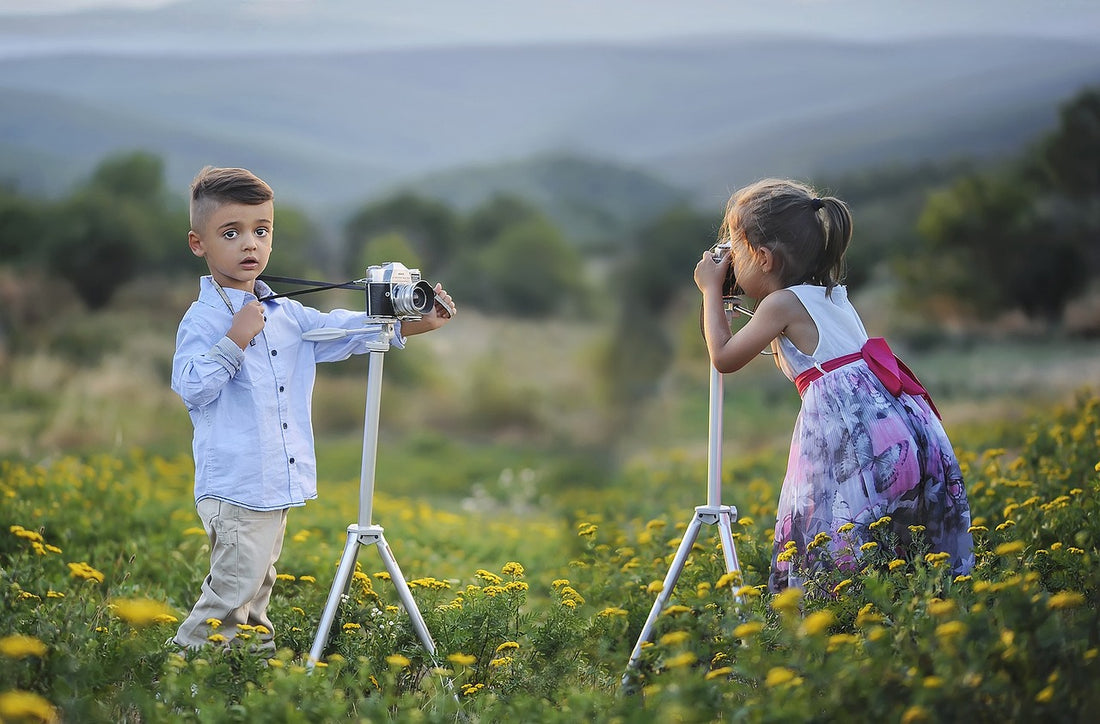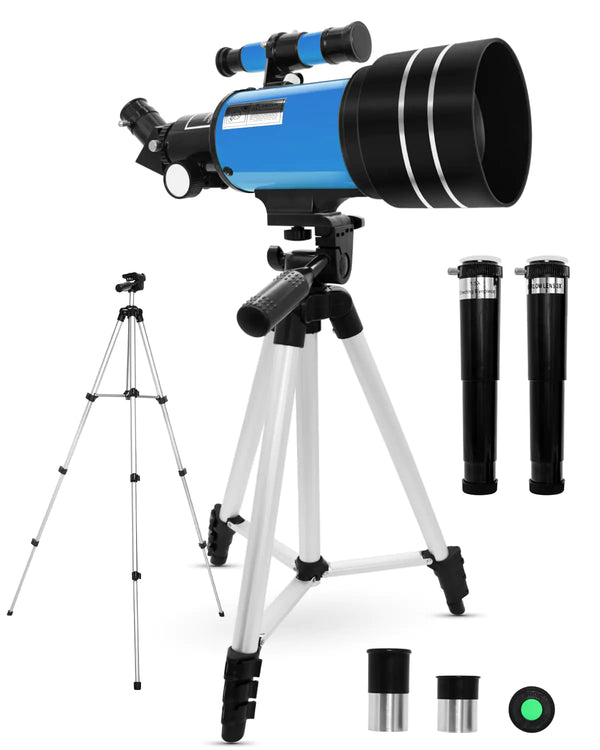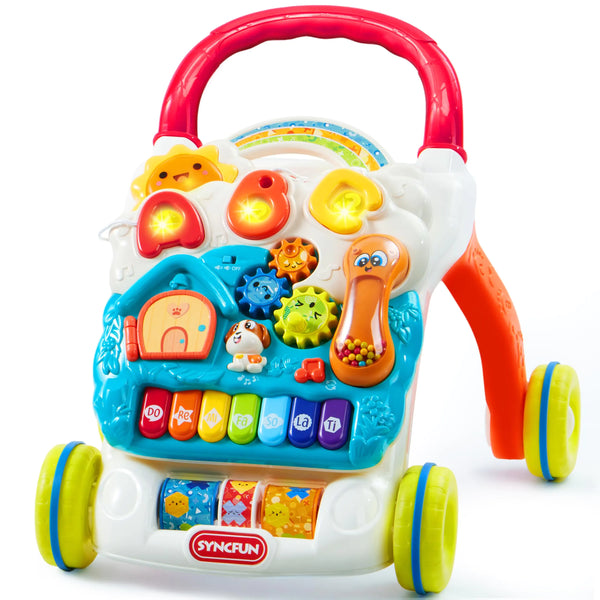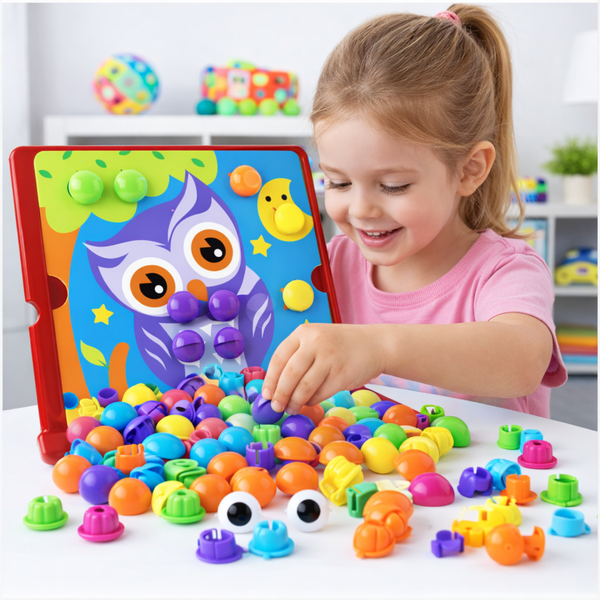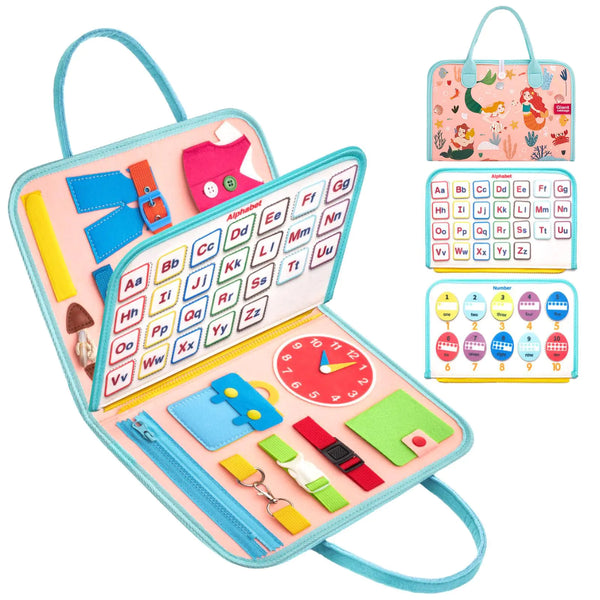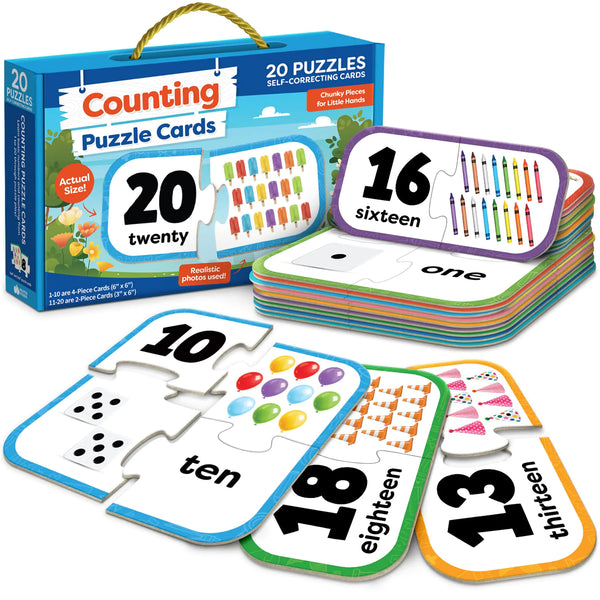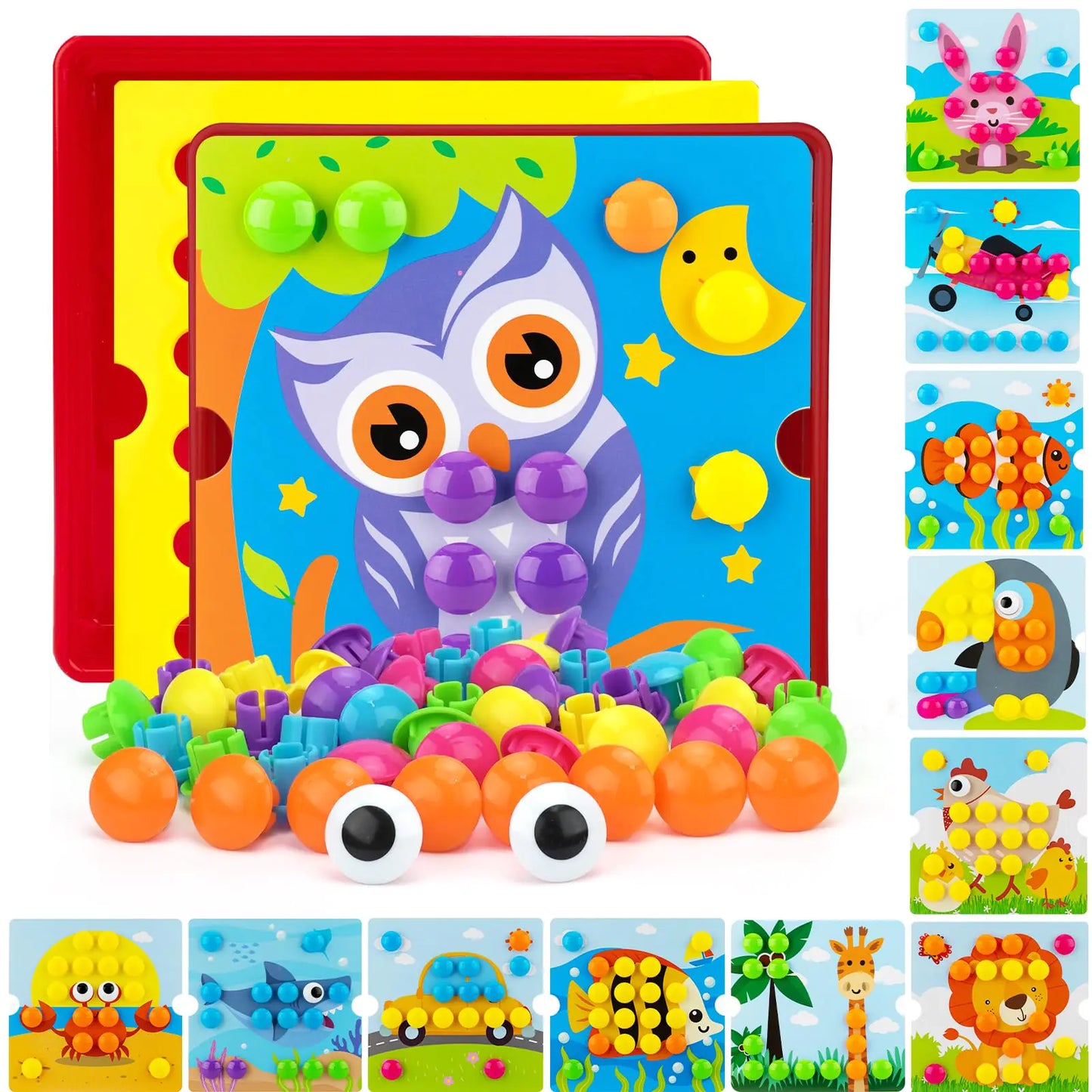Storytelling is a timeless art that not only entertains but also educates, especially for children. Educational toys serve as an excellent medium for storytelling, offering a playful way to enhance language skills, foster creativity, and encourage cognitive development. This article will explore how to use various educational toys to weave enchanting stories that captivate young minds and support interactive, enjoyable learning.
Choosing the Right Educational Toys for Storytelling

Age-Appropriate Selections
When I started looking for educational toys to help my little one craft stories, I realized the importance of choosing age-appropriate toys. It's not just about safety; it's about finding toys that match their developmental stage to foster learning and creativity. For instance, the Little Tikes Story Dream Machine Starter Set is a hit with my kindergartener, sparking joy and excitement in reading.
Toys that grow with your child are a treasure. I found the Petit Collage's Little Library Storytelling Box a gem, with its easy-to-learn mechanics and adaptability for preschoolers and older kids. It's compact enough for storytelling, making every trip an adventure in literacy.
Remember, the right toy can turn a simple playtime into a journey of discovery and learning. It's not just about the price tag; it's about the value it brings to your child's education and imagination.
Here's a quick list of points to consider when selecting storytelling toys:
- Ensure the toy is suitable for your child's age and skill level.
- Look for toys that can adapt as your child grows.
- Choose toys that align with your child's interests to keep them engaged.
- Consider the educational value and how it can enhance your child's storytelling skills.
Themes and Interests
When I hunt for the perfect educational toy to spark my child's storytelling imagination, I always start with their current obsessions. Whether it's dinosaurs, space exploration, or underwater adventures, matching toys to their interests is vital. It's like unlocking a treasure chest of creativity—suddenly, they're not just playing; they're embarking on epic quests and crafting intricate tales.
Here's a little tip: Mix and match themes to keep things fresh. One day, your little one could be exploring a medieval castle, and the next, they could be a scientist in a high-tech lab. This not only keeps their interest piqued but also broadens their horizons.
Remember, the goal is to foster a love for storytelling that goes beyond the toy itself. It's about nurturing a narrative that they can build on, twist, and tell in their own unique way.
And don't forget, while it's tempting to go for the flashiest toy on the shelf, sometimes the simplest ones can be the most versatile. A set of blocks can transform into a cityscape for a superhero saga or the backdrop for a historical epic. It's all about how you and your child bring those pieces to life.
Sensory and Interactive Features
When I'm looking for the perfect educational toy to spark my child's imagination, I always look for sensory and interactive features. These toys are not just playthings; they're gateways to a world of tactile exploration and active learning. Toys with different textures, sounds, and lights can captivate a child's attention, making storytelling truly immersive.
- Here's why sensory toys are a must-have:
- They stimulate the senses, which is crucial for young children's development.
- Interactive elements encourage kids to touch, listen, and engage, enhancing their cognitive skills.
- Sensory-rich toys can help children understand and process the world around them.
By integrating sensory and interactive toys into storytelling, we're not just telling a tale; we're creating a multi-dimensional adventure that they can see, feel, and hear. This approach not only makes the story more engaging but also supports their overall development.
Remember, the goal is to choose toys that will entertain and educate. Whether it's a plush toy made from various fabrics or a musical instrument they can play with, these toys are invaluable tools for developing a child's narrative skills and sparking their lifelong love of stories.
Setting the Scene for Magical Tales

Creating a Storytelling Space
When I think about crafting the perfect storytelling space for my kids, I imagine a cozy corner where their imaginations can run wild. It's not just about having a place to sit; it's about creating an environment that invites creativity and learning. A storytelling space should be a sanctuary where educational toys like dolls, action figures, playsets, and construction toys become the tools for epic adventures. These toys are more than just playthings; they're catalysts for storytelling, role-playing, and cognitive development, fostering social skills and problem-solving abilities.
Here's a simple checklist to get you started:
- Comfortable seating like bean bags or cushions
- A small bookshelf or basket filled with a variety of books
- A selection of educational toys that encourage storytelling
- Adequate lighting, perhaps with a whimsical lamp or string lights
- A dedicated shelf or box for props and costumes
Remember, the goal is to make this space inviting and inspiring. It doesn't have to be elaborate; a few well-chosen items can spark endless stories.
By setting the scene with the right atmosphere and tools, you're not just giving your child a place to play. You provide them with a world to explore, characters to meet, and challenges to overcome. As they play, they learn valuable lessons and develop crucial skills that will benefit them for years to come.
Using Props and Costumes
When I dive into storytelling with my kids, props and costumes become our gateway to imagination. Dressing up and using props can transform ordinary playtime into an extraordinary adventure. It's not just about the fun; it's about the learning too. By engaging in role-play, kids develop language skills and learn to express themselves with confidence.
Props, like the Little Library Storytelling Box coins, spark creativity as kids weave tales around the pictures they see. Costumes add another layer, allowing them to literally step into their characters' shoes! Here's a simple list to get started:
- Safe household items or toys as props
- Themed costumes for an immersive experience
- Educational toys that double as storytelling aids
Encouraging kids to use their surroundings creatively not only enhances their storytelling but also sharpens their problem-solving skills.
Remember, the goal is to create a playful and interactive environment. As I've learned from collaborating with educators, infusing play into teaching makes complex subjects approachable and fun. So, grab some costumes, pick out a few props, and set the stage for a story your kids will love crafting!
Incorporating Music and Sound Effects
I've found that weaving music and sound effects can turn storytime into an enchanting experience.
Interactive toys, such as musical instruments or sound-producing puzzles, can be the perfect backdrop for our tales. Here's a simple list to get you started:
- Use a toy drum to mimic thunder during a stormy scene.
- Shake a tambourine to create the sound of jingling bells in a Christmas story.
- Use a toy keyboard to play a gentle lullaby.
Remember, the key is to keep it fun and light. You don't need to be a maestro to make storytime magical.
And let's not forget the benefits. Incorporating music helps enhance vocabulary, empathy, and even social skills. It's a playful way to introduce concepts like cause and effect as kids see how their actions (like hitting a drum) can produce immediate results (a booming sound). So next time you sit down for storytime, consider reaching for that toy xylophone or a sound effects app. Your little one's imagination will thank you.
From Puzzles to Stories: Building Narratives

Transforming Puzzle Pieces into Characters
When I first introduced puzzles to my little one, I never imagined they'd become the stars of our bedtime stories. But here we are, turning each puzzle piece into a whimsical character with its backstory. It's simple: we pick a piece and ask questions like, 'If this triangle were a person, what would they be like?' Suddenly, a piece isn't just a piece—it's a brave knight or a clever wizard.
The beauty of this approach is how it sparks creativity. We're not just solving a puzzle; we're crafting a world. And the benefits? My kiddo's language skills are soaring, and their problem-solving abilities are getting a serious workout. Plus, it's a blast!
Here's a quick tip I picked up from a game called 'Tabletop Tangram Teambuilding': Create a frame for the characters in the story using a short rope or masking tape. This physical boundary helps my child understand where their story 'lives' and keeps the narrative focused. It's a small step that makes a big difference.
Remember, there's no wrong way to do this. Every story is unique, just like our kids.
Developing Plot with Puzzle Scenarios
When it comes to storytelling, every puzzle piece can be a stepping stone to a new adventure. I've found that using puzzles as a basis for plot development is fun and incredibly beneficial for my kids' cognitive growth. Each puzzle scenario can represent a different chapter in the story, with characters facing challenges and finding solutions as they fit the pieces together.
Puzzles used at home, whether made of wood, cloth, or cardboard, are perfect for small hands to manipulate and for young minds to transform into vibrant story elements. Encourage your children to narrate their playtime adventures to enhance their language development and storytelling skills. Here's a simple way to get started:
- Choose a puzzle that matches your child's interests.
- As they place each piece, ask them to imagine what could happen in the story.
- Use the completed image as the tale's climax, then work backward to create the buildup.
By engaging with the narrative, children not only practice their balancing skills but also learn to sequence events and develop a sense of beginning, middle, and end in storytelling.
Enhancing Problem-Solving with Story Challenges
When it comes to boosting our kids' problem-solving skills, nothing beats the thrill of a good challenge woven into a story. By transforming puzzles into narrative adventures, we're not just giving them a toy but a key to unlock their creativity. Imagine a puzzle that's not just a static image but a dynamic part of a larger tale. Each piece becomes a character or a clue, and as the story unfolds, the challenge intensifies.
Toys that resonate with a child's inclinations include interactive storytelling gadgets like Lunii and Storypod, offering entertainment and education through creativity and multisensory experiences. These aren't just playthings; they're companions on a journey through problem-solving landscapes. Here's a simple way to get started:
- Identify the puzzle or toy that will be the centerpiece of your story.
- Create a storyline that incorporates the puzzle pieces as integral elements.
- Present challenges within the story that can only be solved by completing the puzzle.
Encourage your child to narrate their thought process as they tackle each obstacle. This not only enhances their problem-solving abilities but also nurtures their storytelling skills.
Remember, the goal is to make learning fun and engaging. By integrating puzzles into stories, we're teaching our children to think outside the box and approach problems with adventure and playfulness.
Harnessing the Power of Musical Toys for Storytelling

Instruments as Characters
Imagine your child's favorite toy piano as an instrument and a main character in their musical story. Musical instruments can come to life in the hands of our little ones, each with its own personality and story to tell. A drum might be the tale's brave heart, keeping the adventure's rhythm, while a gentle flute could represent a whimsical friend or a wise guide.
Instruments-as-characters aren't just a fun idea; they're a powerful way to encourage creativity and emotional expression. As children assign roles and voices to their musical toys, they're not just playing—they're learning about empathy, storytelling, and the nuances of emotion that music can convey.
- A toy piano might be the curious explorer, leading the narrative with its melodies.
- Percussion instruments can be the comic relief, providing a beat that gets everyone moving.
- With their rich tones, stringed instruments could be the wise old characters imparting wisdom.
By giving musical toys a role in storytelling, we're not only sparking imagination but also enhancing our children's ability to communicate and express themselves through the universal language of music.
Rhythms and Melodies to Drive the Story
I've discovered that the power of music can turn a simple playtime into an epic storytelling adventure. Rhythms and melodies serve as a story's heartbeat, setting the narrative's pace and tone. When my kids and I incorporate musical toys into our storytelling, we're not just playing but composing a symphony of imagination.
By using different instruments, we can assign unique sounds to characters or events, making the story more vivid and memorable. A gentle lullaby from a xylophone might signify a character's tender moment, while a rapid beat on a drum could herald an exciting chase scene.
Here's a simple way to get started:
- Choose an instrumental piece that matches the mood you want to set.
- Encourage your child to listen and imagine a scene that fits the music.
- Pick out toys that can act out the story and assign them roles based on the music.
- As the music changes, so does the story. Let your child lead the way!
This approach sparks creativity and helps children understand the emotional cues in music. It's a fun way to enhance their auditory skills and narrative abilities. Plus, it's a blast to see what kind of tales we can spin with a few tunes!
Composing Original Story Soundtracks
There's nothing quite like an original soundtrack when bringing stories to life. I've found that using musical toys to compose tunes for our storytelling sessions not only boosts the fun factor but also enhances my kids' learning experience. Creating a unique musical backdrop for each tale helps set the mood and can even become a playful learning activity.
Choosing suitable auditory toys is essential for sensory development. Musical instruments, karaoke machines, and audiobooks can all participate in this creative process. Here's a simple list to get you started:
- Select a variety of musical toys that encourage exploration of sounds.
- Encourage your child to associate different instruments with characters or emotions.
- Experiment with rhythms and melodies to match the story's pace.
- Record your child's music and play it back during storytelling.
Remember, the goal is to balance education and playfulness for optimal growth. The joy of music can give an incredible boost to your child's creativity and storytelling skills.
Interactive Tech Toys: A New Dimension of Storytelling

Projectors and Flashlights for Visual Tales
I've found that using projectors and flashlights can turn a simple story into an enchanting visual experience for kids. Projectors like the MiDeer Light Projector display vivid images and encourage children to follow along with a storybook description, making it a multifunctional storytelling tool. Imagine the excitement as they hold the handle, project tales onto the wall, and watch the story unfold with each slide.
Interactive storytelling with these devices can be a game-changer. Here's a quick list of benefits:
- Engages children's visual senses
- Enhances imagination and creativity
- Supports language development
- It provides a unique way to experience stories
By incorporating projectors and flashlights into storytelling, we create a dynamic atmosphere that captivates young minds and stimulates their curiosity.
Whether it's a bedtime story or an afternoon adventure, these tools can bring stories to life in ways traditional books alone cannot. And the best part? It's a fun experience that the whole family can enjoy together.
Coding Toys for Creating Interactive Stories
As a parent, I've seen firsthand how coding toys can turn storytime into an interactive adventure. These toys let kids become the authors of their tales, programming characters and events that unfold in real time. Coding toys are more than just fun; they're educational powerhouses. They teach children the basics of programming logic, a critical skill in today's digital world.
- Choose a coding toy that matches your child's age and skill level.
- Set a storytelling goal: Encourage your child to create a straightforward narrative using the toy.
- Program together: Work with your child to bring the story to life through coding.
By integrating coding toys into storytelling, we're not just entertaining our kids; we're preparing them for a future where technology is woven into every aspect of life. And the best part? They're learning through play, which is the most natural way for kids to learn.
From the Osmo Coding Starter Kit to the Coding Critters, a wide range of toys caters to diverse interests and skill levels. Whether your child is just starting out or already has some coding chops, there's a toy out there that can help them craft their own interactive stories.
Educational Apps that Narrate and Animate
I've found that educational apps are a game-changer in storytelling. They bring stories to life with narration and animation, making the experience immersive for kids. Tech toys and educational apps engage kids in learning through play, fostering skills in programming, problem-solving, and more. Screen time becomes a fun, educational adventure for children.
Interactive educational games blend entertainment with learning, reinforcing essential concepts through colorful graphics and exciting challenges. It's a hands-on approach that enhances knowledge while fostering critical thinking.
By simply touching the pages with a pen or swiping on a screen, kids can interact with stories in ways that were never possible before. They're not just passive listeners; they become active participants in the narrative.
And let's not forget the convenience factor. With apps, a vast library of stories is just a tap away, ready to be explored anytime, anywhere. It's storytelling magic right at our fingertips!
STEM Toys: Engineering Stories of Discovery

Building Blocks for Plot Development
I often turn to the trusty building blocks when I think about crafting stories with my kids. These aren't just toys but the foundation for imagination and narrative construction. Educational building sets enhance cognitive development, motor skills, creativity, and teamwork. They're like the bricks of a child's growing mind, each block a stepping stone in their learning journey.
Here's a simple way to get started:
- Choose a set of building blocks that matches your child's interests.
- Encourage them to build a scene related to a story they love or invented.
- Ask questions about the characters and the setting they've created.
- Introduce challenges or new elements for them to incorporate, spurring on their problem-solving skills.
By using building blocks, we're not just playing; we're setting the stage for our children to become storytellers, architects of their own worlds. It's a joy to watch their tales take shape, one block at a time.
Remember, STEM toys merge play with learning, preparing kids for future success in STEM fields. And don't forget, choosing age-appropriate toys is key to maximizing development.
Science Kits for Exploratory Narratives
When I first introduced my kids to science kits, I was amazed at how quickly they turned experiments into epic adventures. Science kits are not just about learning facts; they're about weaving those facts into stories that captivate young minds. For instance, a simple chemistry set can become the potion lab of a mad scientist, with each experiment contributing to a larger narrative of discovery and intrigue.
- Here are a few ways to use science kits for storytelling:
- Relate the experiments to real-world problems or mysteries.
- Encourage kids to personify elements or compounds as characters in their tales.
- Use the scientific method as a plot device, with hypotheses leading to climactic experiments.
By guiding our children to see the magic in science, we're not just teaching them about the world; we're helping them to become more creative and effective storytellers. And isn't that a wonderful way to spark their passion for learning?
Math and Engineering Challenges as Story Elements
When we introduce our kids to STEM toys, we're not just giving them something to play with; we're opening the door to a world of learning. Math and engineering challenges can be the perfect story elements for our little ones to discover the joy of problem-solving. Imagine a tale where each math puzzle or construction set is a quest, with our kids as the heroes, overcoming obstacles.
- Start with a simple math toy, such as counting blocks, to lay the story's foundation.
- Introduce a construction challenge that the characters must solve to progress the story.
- Use the outcomes of these challenges to shape the narrative and create a sense of achievement.
By weaving math and engineering toys into storytelling, we're not just entertaining our kids; we're helping them develop critical thinking and spatial awareness. It's a subtle yet powerful way to enhance their education while they play.
Remember, the goal is to make learning an exciting adventure. As they build and solve, they're not just playing but creating stories of triumph and ingenuity. And the best part? They're learning valuable skills that will serve them well throughout their lives.
Crafting Stories with DIY Educational Toy Kits

Customizing Characters with Arts and Crafts
One of the most exciting aspects of storytelling with educational toys is the ability to customize characters using arts and crafts. It's a fantastic way to bring a personal touch to the stories we create with our kids. By crafting unique characters, we bring our tales to life and encourage our children to invest in the narrative emotionally.
For example, drawing inspiration from DIY Julia Donaldson-inspired crafts, we can create Stick Man puppets or a Gruffalo Sensory Bin. These hands-on activities enhance the storytelling experience, develop fine motor skills, and foster creativity. Here's a simple list to get started:
- Stick Man Puppets
- Gruffalo Sensory Bin
- Room on the Broom Stick Craft
- Stickman Sun Catchers
Remember, the goal isn't perfection; it's about the joy and learning that comes from the process of creation. Let your child's imagination run wild as they craft their story's protagonists and villains. The pride they take in their handmade characters will shine through in the stories they tell.
Designing Sets and Backgrounds
When I craft stories with my kids, designing the sets and backgrounds is where our creativity really comes to life. We start by choosing a theme, whether it's a bustling cityscape or a tranquil forest. Then, we gather materials from around the house—cardboard boxes, fabric scraps, and even natural elements like leaves and twigs. The goal is to create an immersive environment that sparks the imagination.
- Choose a theme for your story.
- Gather materials from around the house.
- Create an immersive environment.
By involving the kids in this process, they learn about composition and spatial awareness while also getting a hands-on lesson in recycling and repurposing. It's a win-win situation: They're simultaneously developing essential skills and having a blast. And let's not forget: This is a fantastic way to encourage learning through tech and tactile play, fostering creativity and cognitive growth.
Role-playing with educational toys sparks imagination and enhances learning experiences, promoting lifelong skills.
Storytelling through Toy Photography
One of the most enchanting ways to bring stories to life is through toy photography. It's a creative outlet that captures the imagination and preserves the magical moments of childhood. By arranging toys and snapping pictures, kids can create and share their own narratives, giving a visual dimension to their tales.
Here's how we can get started:
- Choose a theme for the story and select toys that fit the narrative.
- Set up a mini 'stage' using everyday items as props.
- Experiment with lighting to enhance the mood of the scenes.
- Encourage kids to take photos from different angles to find the best shot.
This process not only nurtures their artistic skills but also enhances their storytelling abilities. It's a fun way to develop a keen eye for detail and composition.
Remember, the goal isn't perfection; it's about the joy and learning that come from the act of creation. And who knows? Maybe one day, these photographic stories crafted by little hands will become treasured keepsakes reminiscent of when every playtime was an adventure waiting to be captured.
Incorporating Cultural and Historical Toys for Richer Stories

Exploring Myths and Legends
One of the most enchanting ways to spark my child's imagination is by delving into the world of myths and legends with educational toys. These stories, rich with heroes, creatures, and quests, offer a treasure trove of adventures that can be brought to life right in our living room.
By incorporating toys that represent various mythological figures and settings, we can create a multisensory storytelling experience that entertains and educates us. This is a fantastic way to introduce my child to different cultures and their histories, in a way that's both fun and memorable.
Here's a simple way to get started:
- Choose a myth or legend that resonates with your child's interests.
- Select toys that align with the story's characters and settings.
- Encourage your child to act out the story, using the toys to represent different aspects of the tale.
This approach to storytelling is not just about having fun; it's a powerful tool for teaching values, traditions, and history. It fosters a deeper connection with the past and a better understanding of the world's rich cultural tapestry.
And let's not forget the benefits of such interactive play. It enhances language skills, boosts creativity, and nurtures a lifelong love of storytelling. I've seen firsthand how my child's eyes light up with every new mythological adventure we explore together.
Learning History through Storytelling
I've found that using educational toys to dive into history with my kids is like opening a treasure chest of stories. Each toy becomes a time machine, whisking us away to ancient civilizations, battles for independence, or the inspiring lives of historical figures. We explore myths and legends, bringing characters to life through figurines and playsets that represent different eras.
- Here's how we make the most of it:
- We start with a toy representing a historical period, like a castle or a pioneer wagon.
- Next, we read about that era together, using books or educational apps.
- Then, we re-enact famous events or create our own stories, using the toys as props.
By engaging with history in this hands-on way, my kids develop a deeper understanding and appreciation for the past. It's not just about memorizing dates and names; it's about feeling connected to the stories that shaped our world.
And let's not forget the benefits. These storytelling sessions aren't just fun; they're a gateway to critical thinking and empathy. As we discuss the moral lessons from historical events, my kids learn to consider different perspectives and the consequences of actions. It's a powerful way to nurture their emotional intelligence while they learn about history.
Cultural Toys as Gateways to World Stories
I've found that introducing cultural toys into playtime is like opening a treasure chest of stories from around the world. These toys serve as a bridge, connecting kids to the vast diversity of human heritage. Imagine your child holding a traditional Japanese Kokeshi doll, and together, you explore the folklore behind its creation. Or perhaps they're piecing together a puzzle that depicts a famous historical scene, sparking questions and a desire to learn more.
- Cultural toys can be a fantastic way to teach children about different societies and epochs. Here's a quick list of benefits:
- They foster a sense of global awareness and curiosity.
- Kids learn to appreciate and respect different cultures.
- These toys often come with rich backstories, perfect for creative storytelling.
By integrating cultural toys into play, we're not just giving our kids something to play with; we're giving them a window into the world's tapestry of traditions and histories. It's a playful and engaging way to enrich their understanding and empathy for people from all walks of life.
Tips for Parents: Facilitating Storytelling Play

Guiding Without Dictating
As a parent, I've learned that the key to fostering a love for storytelling in my kids is to guide their play without dictating it. It's about striking a balance between providing structure and allowing freedom. Here's how I do it:
- I start by fostering creativity with open-ended questions, encouraging my kids to think outside the box.
- I encourage and celebrate their unique ideas, boosting their confidence to tell their stories.
- Respecting their interests is crucial; it keeps them engaged and makes learning through play more meaningful.
- I integrate educational concepts subtly, using toys that naturally lead to learning moments.
By choosing the right toys, I ensure that our playtime is a mix of structured activities and free exploration. This approach not only nurtures their storytelling skills but also their overall cognitive development.
Remember, the goal is to create a rich environment where kids can express themselves and learn at their own pace. It's about being there to support and guide, not to control the narrative. This way, they develop a sense of ownership over their stories, which is incredibly empowering.
Encouraging Expression and Creativity
As a parent, I've seen firsthand how educational toys can be a springboard for my child's imagination. Toys are not just playthings; they're tools that help kids express themselves in myriad ways. Whether it's through a puppet that helps them articulate their feelings or building blocks that let them construct their narratives, the possibilities are endless.
One of the most significant benefits of educational toys is their ability to facilitate open-ended play. This kind of play doesn't have a predetermined outcome, so kids are free to create their own endings, characters, and scenarios. It's a joy to watch my child get lost in a world of their own making, and it's even more rewarding to see them develop their emotional intelligence as they do. Even puppets help promote empathy, self-expression, and understanding of different points of view.
Encouraging your child to share their creations and stories with you can be a wonderful bonding experience. It's a chance to see the world through their eyes and to celebrate their unique perspective.
Here's a simple list of activities that can help foster creativity in your child:
- Provide a variety of toys that encourage storytelling, such as dolls, action figures, and playsets.
- Set aside time for regular story-making sessions, where you can co-create stories with your child.
- Ask open-ended questions about their toy-based narratives to encourage deeper thinking and elaboration.
Expanding Vocabulary with Storytelling
As I weave stories with my child, I've noticed a delightful expansion in their vocabulary. Educational toys are not just playthings; they're tools for language growth. Kids grasp and retain new words more effectively when they are introduced in the context of a story. Here's a simple approach I use:
- Start with a toy with a theme, like a farm or a castle.
- Name each element and describe its function or story role.
- Encourage your child to repeat the words and add their descriptions.
By actively engaging with the story and its characters, children naturally pick up new words and phrases, enriching their language skills.
Remember, the goal is to make learning fun. Don't correct every mistake; celebrate their attempts and gently guide them. You'll be amazed at how quickly their vocabulary blossoms!
Storytelling Games and Activities for Groups

Collaborative Storytelling Challenges
When it comes to fostering a love of storytelling in our kids, there's nothing quite like the magic of collaboration. Encourage learning through play with educational toys that spark imagination and promote teamwork and social skills. Imagine a group of kids, each with their own unique toy, coming together to weave a tale that's greater than the sum of its parts. It's not just about the story but the bonds they form and the creativity they unleash.
By introducing collaborative storytelling challenges, we create a fun and dynamic way to enhance problem-solving skills. Kids learn to listen, adapt, and contribute, turning playtime into a rich learning experience.
Here's a simple activity to get started:
- Assign roles based on the toys available.
- Set a theme or problem to solve within the story.
- Encourage each child to contribute a piece of the narrative.
- Celebrate the completed story with a group sharing session.
This approach entertains and educates as children explore new vocabulary and concepts in a group setting. It's a win-win for parents looking to boost their child's development in a joyful, engaging way.
Role-Playing with Educational Toys
When I bring out the educational toys for a role-playing session, I can almost see the gears turning in my little one's head. It's not just about having fun—though there's plenty of that—it's about stepping into a character's shoes and seeing the world through a different lens. Role-playing with educational toys is a fantastic way to foster empathy and social skills in kids.
- Encourage cognitive development with building blocks.
- Emotional understanding with dolls
- Learning through educational toys like alphabet books
By assigning roles and scenarios, kids practice real-world interactions in a safe and controlled environment. They negotiate, share, and make decisions, all while playing. It's like they're learning life's big lessons in miniature! And the best part? They're developing language skills and expanding their vocabulary without even realizing it.
With each toy, a new adventure begins, and with each role-play, a story unfolds. It's a joy to watch my child navigate these tales, learning and growing with every play session.
The possibilities are endless, whether it's a doctor's kit that sparks a game of hospital or a set of dress-up clothes that transforms them into knights and princesses. And I keep the playtime inclusive and open-ended, allowing my child to lead the way.
Storytelling Competitions and Rewards
When it comes to wrapping up a storytelling session with a bang, nothing beats friendly competition. Encouraging a little healthy rivalry among kids can be a fantastic way to get their creative juices flowing. Here's how I like to do it:
- Start with a theme: Pick one that resonates with the kids or relates to their learning.
- Set clear rules: Ensure everyone understands how to participate and what's expected.
- Offer rewards: Small incentives can go a long way. Think stickers, extra playtime, or a unique storybook.
Remember, the goal isn't just to win, but to have fun and learn along the way.
By turning storytelling into a game, we make it more exciting and reinforce the educational benefits. Kids learn to express themselves, expand their vocabulary, and improve their social skills. And when there's a little prize at the end, you bet they'll be eager to dive into the world of stories!
Unleash the power of play and imagination with our curated storytelling games and activities, perfect for group fun! Whether you're hosting a family game night or leading a classroom activity, our interactive puzzles and educational toys are designed to spark creativity and enhance cognitive skills. Don't miss out on the joy and learning opportunities - visit Wonder Kids Toy Store today and discover a world of adventure and excitement for kids of all ages!
Wrapping Up the Storytelling Adventure
And there you have it, folks! We've journeyed through the whimsical world of educational toys and uncovered their secret power to tell stories. From projecting bedtime tales to piecing together puzzles that spark the imagination, these toys are not just playthings but gateways to endless stories. Remember, the key to a magical storytelling experience lies in the interaction between you, your little one, and the toy. So pick up that storytelling box or musical puzzle, and let the stories unfold in the most playful way possible. Who knows what fantastic tales you'll create together? Happy storytelling!
What are educational toys for storytelling?
Educational storytelling toys are designed to enhance children's narrative skills, creativity, and language development through interactive, imaginative play. They often include features that allow children to create and tell their own stories using the toy as a medium.
How can I choose a suitable educational toy for my child's age?
Select toys that match your child's developmental stage. For younger children, choose toys with simple stories and interactive elements. Older children may enjoy more complex toys that challenge their problem-solving skills and creativity.
Can puzzles be used for storytelling?
Yes, puzzles can be transformed into storytelling tools by using the pieces as characters or elements of a story. This encourages children to use their imagination and develop narratives as they solve the puzzle.
How can musical toys be incorporated into storytelling?
Musical toys can be used as characters or to create a mood with rhythms and melodies. Children can also compose original soundtracks to accompany their stories, enhancing the storytelling experience.
What are some interactive tech toys that are good for storytelling?
Interactive tech toys like projectors, coding, and educational apps can bring stories to life with visual and interactive elements, making storytelling more engaging and dynamic for children.
How can STEM toys be used to create stories?
STEM toys, such as building blocks and science kits, can be used to construct story settings or to create exploratory narratives that integrate STEM elements into the storytelling process.
What are some tips for parents to facilitate storytelling play?
Parents can guide their children without dictating, encourage expression and creativity, and help expand their children's vocabulary. Providing a supportive environment where children feel comfortable sharing their stories is essential.
Are there storytelling games and activities for groups?
Yes, collaborative storytelling challenges, role-playing activities with educational toys, and storytelling competitions can be enjoyed in group settings, fostering social skills and teamwork.

